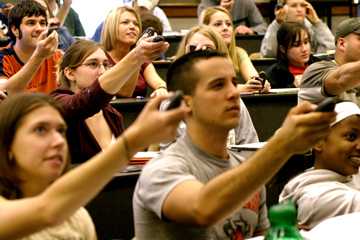Thriving in a colder and more challenging climate: Part 1
The Annual ALT-C (Association for Learning Technology) is ‘The’ conference for us learning technologists. It is usually a very busy conference with a jam-packed programme and varied presentations. This year the theme was ‘Thriving in a colder and more challenging climate’.
The typical attendees at ALT-C are learning technologists, or project members from different institutions on JISC-funded programmes, consultants to JISC projects and e-learning researchers. It is always good to look around at the various presentations and observe what technologies are others using. This year, the ubiquity of iPads or tablets (some laptops) and smartphones in the audience was clear: most people used these devices during sessions to take notes, search the internet or for tweeting during sessions. I sat beside a learning technologist, who, annoyed by the bad visi-and-audibility in the room, looked up the presenter’s work on the Internet and decided to read it while she was (inaudibly) speaking / trying to speak through the air conditioning. At first I thought he had just got his laptop out to look at emails… but instead multi-tasking is definitely apparent and takes quite varied forms!
This year, a welcome addition to the conference was the use of CrowdVine, a ‘social networking and timetabling tool. Participants could log on prior to the conference, create a profile, add a bit of information about themselves; we were also able to look through the programme and click on sessions of interest, which we then moved into our own personal timetable. The site was accessible via smartphones, so there was no need to print the programmes; a sample screen as to how it looked is shown in the screenshot below.

The opening keynote was given on ‘Plan Ceibal’, the one laptop per child in Uruguay, an impressive governmental initiative with lots of commitment and the audience couldn’t quite contain some jealousy about the commitment given in Uruguay to improving access to technologies for the purpose of social inclusion. (See also Wikipedia’s entry on Plan Ceibal.)
Demonstrating the significance of JISC‘s commitment to technology-enhanced learning was the fact that about 8 of 12 papers I saw on the first day were reporting on a JISC-funded project. A shift in the kind of papers was also about projects moving from small departmental, one-off projects towards programmes that are at the institutional level with high involvement from senior stakeholders; a recognition that success only comes from this kind of senior-level involvement. The Curriculum Design programme for instance had a number of presentations from JISC, which are very relevant for our own institutional curriculum review, and there is a wealth of resources on the JISC Design Studio that are well worth looking up.
A number of vendors were represented, including Learning Objects (see our Campus wiki, blog tools in VITAL), Turning point, Moodlerooms (hosted Moodle services), and a surprise to me, but maybe not too surprisingly Google with Eduapps who are clearly interested in the education market.
More on ALT-C 2011 to follow soon.
Tünde and Paul


